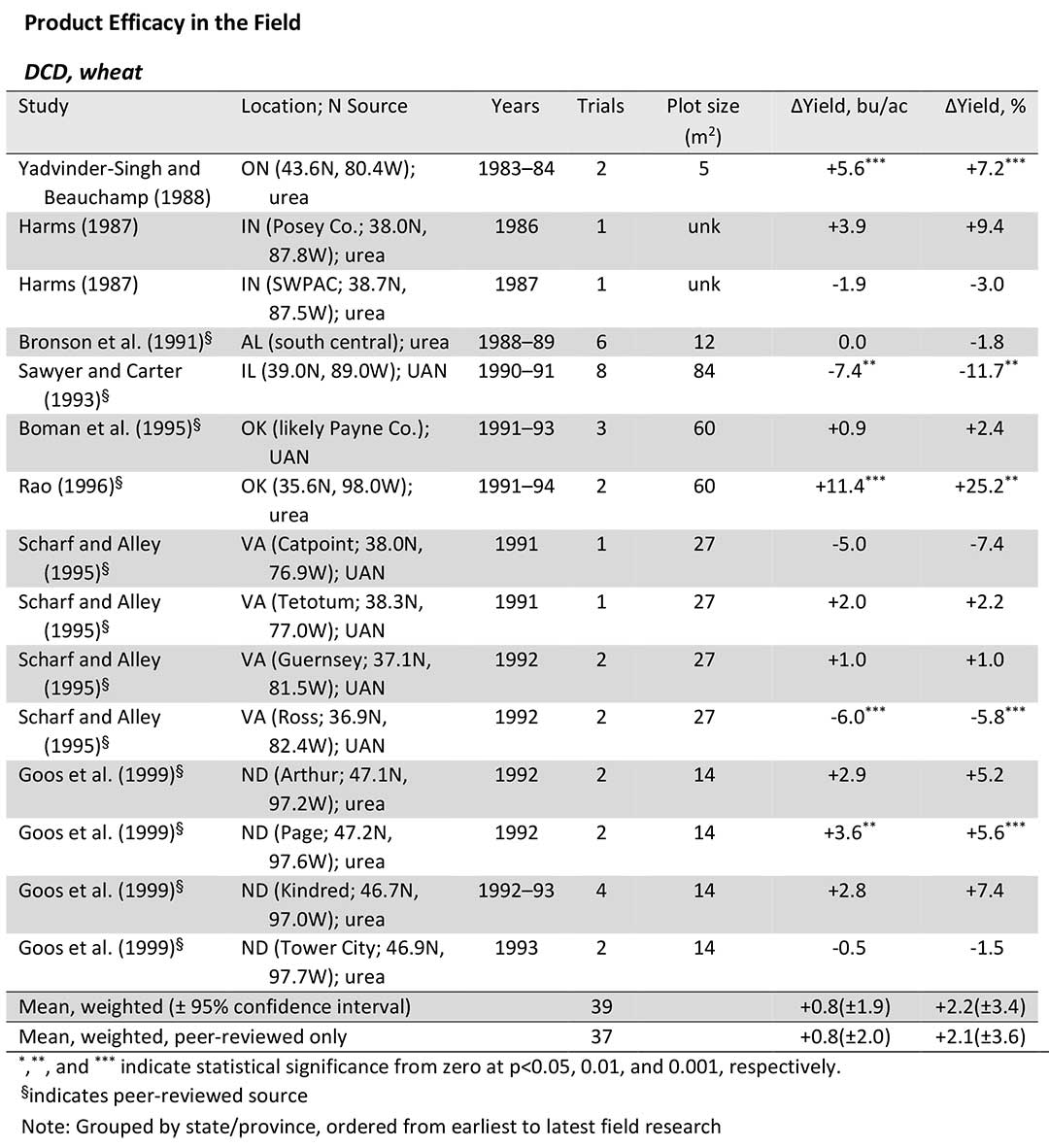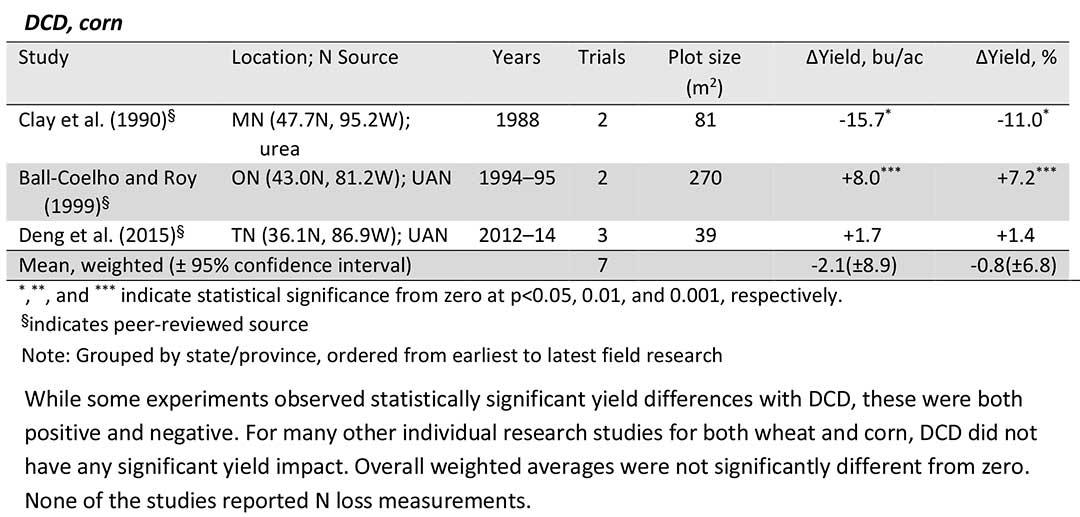DCD Research Findings
The research findings reported here were obtained from a literature review performed by Alison Eagle of Duke University (Nicholas Institute for Environmental Policy Solutions) in December 2015 under contract to the Environmental Defense Fund.
Dicyandiamide, or DCD, is commonly used in fertilizer formulations as a nitrification inhibitor to slow the release rate of nitrogen (N) into plant available forms that are also more prone to losses. DCD has been used extensively worldwide for more than 40 years, and has been approved by the U.S. EPA as a nitrification inhibitor since the late 1990s. First developed by the Japanese chemical engineering firm Showa Denko, DCD is now an active ingredient in many mainstream enhanced-efficiency fertilizer products used in the U.S., including Guardian® products, Agrotain® Plus, and Super U® (Trenkel 1997). The DCD in these products is intended to inhibit the activity of the Nitrosomonas bacteria, allowing for the stabilization of ammonium-N in the root zone, improving plants’ access to available nitrogen over the growing season. As a result, the addition of DCD has the potential to increase crop yields as well as reduce nitrogen loss through nitrification (Conklin Company 2012). Depending on the specific product being used, DCD can be applied with either liquid or dry fertilizer, and is used with both inorganic fertilizer as well as liquid manure.
Some of the earliest laboratory soil incubation studies done in North America using DCD investigated its ability to inhibit nitrification and increase the amount of ammonium-N available to plants in the root zone. Reddy (1964a) observed that DCD had a toxic effect on nitrifying organisms, clearly inhibiting nitrification, but not altogether preventing it. He also noted that the effectiveness of DCD application for nitrification inhibition varied by soil type. The results of an early grassland field experiment in Canada also showed that DCD could be equally as effective as nitrapyrin at inhibiting nitrification when injected with anhydrous ammonia (Ashworth and Rodgers 1981).
While early research into DCD as a nitrification inhibitor provided positive results, other research revealed that phytotoxicity could be an issue when it comes to DCD’s ability to improve crop yields. In a separate study, Reddy (1964b) found that the addition of DCD could increase yields of Coastal bermudagrass, but the same application decreased dry matter yields of wheat, oats, maize, cotton, and tomato and showed visible signs of DCD toxicity (leaf tip and margin chlorosis and necrosis). Later research by Reeves and Touchton (1986) noted that commercial N fertilizers formulated with DCD have a safe concentration for broadcast application, but could cause significant phytotoxicity in plants if applied in bands, thus causing yield reductions as opposed to yield improvements.
A search of the scientific literature and grey literature (conference proceedings etc.) was conducted to locate data on crop yield responses for DCD. Data were incorporated into an existing database on fertilizer management field trials, including all available management, climate, soil, N loss, and crop productivity information.
The following tables and discussion summarize the yield impacts of DCD when applied along with fertilizer N. Weighted averages are calculated where possible, with results from each study weighted by the inverse of the number of trials in each location. This prevents studies from very well-studied locations from overwhelming the average results.
Overall effect sizes are reported for all studies, with effect sizes also restricted to peer-reviewed data, as applicable.


While some experiments observed statistically significant yield differences with DCD, these were both positive and negative. For many other individual research studies for both wheat and corn, DCD did not have any significant yield impact. Overall weighted averages were not significantly different from zero. None of the studies reported N loss measurements.
With the data available, and in the conditions studied, DCD did not have any beneficial yield impacts for either wheat or corn. Some of the studies reporting yield decline may not have fully considered the potential for phytotoxicity with certain application methods. In addition, there are soil and climatic conditions under which DCD is expected to be more beneficial than others. For example, Malzer et al. (1989) noted some benefits to DCD in coarse-textured soils with potentially high nitrate losses. Therefore, if DCD is to be recommended as a product for improving N use efficiency, more research (or increased accessibility of existing field data) is needed to determine the climate and soil characteristics or other management practices most likely to see such benefits.
Ashworth, J. and G. Rodgers. 1981. The compatibility of the nitrification inhibitor dicyandiamide with injected anhydrous ammonia. Canadian Journal of Soil Science 61(2):461–63.
Ball-Coelho, B.R. and R.C. Roy. 1999. Enhanced ammonium sources to reduce nitrate leaching. Nutrient Cycling in Agroecosystems 54(1):73-80.
Boman, R.K., R.L. Westerman, W.R. Raun and M.E. Jojola. 1995. Spring-applied nitrogen fertilizer influence on winter wheat and residual soil nitrate. Journal of Production Agriculture 8(4):584-589.
Bronson, K.F., J.T. Touchton, R.D. Hauck and K.R. Kelley. 1991. N-15 RECOVERY IN WINTER-WHEAT AS AFFECTED BY APPLICATION TIMING AND DICYANDIAMIDE. Soil Science Society of America Journal 55(1):130-135.
Clay, D.E., G.L. Malzer and J.L. Anderson. 1990. TILLAGE AND DICYANDIAMIDE INFLUENCE ON NITROGEN-FERTILIZER IMMOBILIZATION, REMINERALIZATION, AND UTILIZATION BY MAIZE (ZEA-MAYS L). Biology and Fertility of Soils 9(3):220-225.
Conklin Company. 2012. Guardian-DF and Guardian-DL Nitrogen Fertilizer Additive Specification Sheet. Conklin Company, Shakopee, MN. www.conklin.com.
Deng, Q., D.F. Hui, J.M. Wang, S. Iwuozo, C.L. Yu, T. Jima, D. Smart, C. Reddy and S. Dennis. 2015. Corn Yield and Soil Nitrous Oxide Emission under Different Fertilizer and Soil Management: A Three-Year Field Experiment in Middle Tennessee. Plos One 10(4).
Goos, R.J., J.A. Schimelfenig, B.R. Bock and B.E. Johnson. 1999. Response of spring wheat to nitrogen fertilizers of different nitrification rates. Agronomy Journal 91(2):287-293.
Harms, C.L. 1987. Improved N Use Efficiency for Wheat in Southwest Indiana. 17th North Central Extension-Industry Soil FErtility Conference Proceedings 3:1-7.
Malzer, G.L., K.A. Kelling, M.A. Schmitt, R.G. Hoeft and G.W. Randall. 1989. Performance of dicyandiamide in the North Central states. Communications in Soil Science & Plant Analysis 20(19–20):2001–22.
Rao, S.C. 1996. Evaluation of nitrification inhibitors and urea placement in no-tillage winter wheat. Agronomy Journal 88(6):904-908.
Reddy, G.R. 1964a. Effect of mixing varying quantities of dicyandiamide with ammonium fertilizers on nitrification of ammonia in soils. Canadian Journal of Soil Science 44(2):254–59.
Reddy, G.R. 1964b. Effect of varying quantities of dicyandiamide on the utilization of nitrogen by several crops from sodium nitrate and ammonium sulphate. Journal of Agricultural Science 62(1):35–38.
Reeves, D.W. and J.T. Touchton. 1986. RELATIVE PHYTOTOXICITY OF DICYANDIAMIDE AND AVAILABILITY OF ITS NITROGEN TO COTTON, CORN, AND GRAIN-SORGHUM. Soil Science Society of America Journal 50(5):1353-1357.
Sawyer, J.E. and J.L. Carter. 1993. UREA-AMMONIUM NITRATE MANAGEMENT-TECHNIQUES FOR WINTER-WHEAT PRODUCTION. Journal of Production Agriculture 6(1):62-67.
Scharf, P.C. and M.M. Alley. 1995. Nitrogen loss inhibitors evaluated for humid-region wheat production. Journal of Production Agriculture 8(2):269–75.
Trenkel, M.E. 1997. Controlled-Release and Stabilized Fertilizers in Agriculture. International Fertilizer Industry Association, Paris.
Yadvinder-Singh and E.G. Beauchamp. 1988. Response of winter wheat to fall-applied large urea granules with dicyandiamide. Canadian Journal of Soil Science 68(1):133-142.
